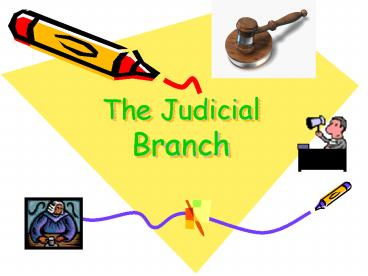The Judicial Branch - PowerPoint PPT Presentation
1 / 22
Title: The Judicial Branch
1
The Judicial Branch
2
1. The Judicial Branch contains the United States
Supreme Court and lower federal courts.
A. This is the current US Supreme Court and it
consists of 9 Justices
3
2. The main power of the Judicial Branch is called
- JUDICIAL REVIEW
4
- A. JUDICIAL REVIEW means the courts can determine
whether a law is constitutional or not.
5
- B. Even if the whole Congress and the President
pass a law, the Supreme Court can say that it is
unconstitutional and that it does not apply.
6
(No Transcript)
7
3. The Legislative Branch is also responsible
for setting up lower federal courts.
8
- A. All Supreme Court cases have been appealed
from lower federal courts. - B. If you appeal a case, it means you want to
give the case another chance. You cannot appeal
a case higher than the US Supreme Court. - C. The Supreme Court is the only court that gets
to choose which cases it wants to hear. - D. If they choose not to hear a case, the ruling
of the lower court stands.
9
4. Supreme Court Justices are appointed for life,
that is, they get to keep their job until they
quit/retire, or do something bad and get
impeached.
10
5. How does someone become a Supreme Court
Justice?
- A. Supreme Court Justices are not elected!!!
- B. If a vacancy occurs in the Supreme Court, the
President recommends someone new to the Senate. - C. The Senate votes on whether or not they should
get the job.
11
POP QUIZ!!!!!!!!
12
- 1. What is the main power of the Judicial Branch
called? - 2. How does a Supreme Court Justice get their job?
13
BONUS!!!
- Why is it a good idea for Justices to be
appointed instead of elected?
14
6. Thomas Jefferson said the Judicial Branch is
the weakest branch of the government because it
does not have the power of the
- Purse
- or the
- Sword
15
7. The Supreme Court has ruled on many
controversial cases including the following
topics
- Abortion in Roe V. Wade
- Flag burning in Texas v. Johnson
- Rights of the Accused in Miranda V. Arizona
- Students rights in TLO V. New Jersey
16
(No Transcript)
17
(No Transcript)
18
- Tinker v. Des Moines Decision
- The U.S. Supreme Court ruled in favor of Tinker
in this case. - The U.S. Supreme Court ruled 7-2 against the
school and in favor of the students wearing the
armbands, provided their actions or speech do not
interfere with school work or the rights of
others in the classroom.
19
(No Transcript)
20
- Bethel v. Fraser Decision
- The U.S. Supreme Court ruled in favor of the
Bethel school district in this case. The
school's interest in prohibiting vulgar and lewd
speech outweighed whatever First Amendment
interests the student might have had, especially
since the penalties were unrelated to any
political viewpoint.
21
(No Transcript)
22
- Texas v. Johnson Decision
- The U.S. Supreme Court ruled in favor of Johnson
in this case. The Court in a 5-4 ruling said that
the Texas law violated the First Amendment as
applied to Johnson's act since it determined that
the prosecution of Johnson was directly related
to expression.































